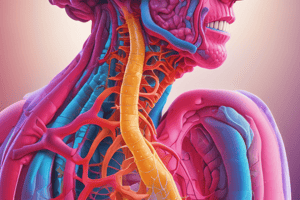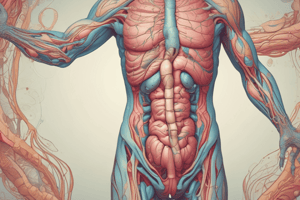Podcast
Questions and Answers
What primarily initiates the act of vomiting?
What primarily initiates the act of vomiting?
- Interaction between the vomiting center and chemoreceptor trigger zone (correct)
- Regulation of blood pressure
- Contraction of abdominal muscles alone
- Activation of the digestive enzymes
Which of the following conditions is not commonly associated with prolonged and severe vomiting?
Which of the following conditions is not commonly associated with prolonged and severe vomiting?
- Dehydration
- Hyperlipidemia (correct)
- Alkalosis
- Hypokalemia
Which part of the brain contains the vomiting center?
Which part of the brain contains the vomiting center?
- Hypothalamus
- Cerebral cortex
- Cerebellum
- Dorsal portion of the lateral reticular formation of the medulla (correct)
What physical changes occur during the vomiting act?
What physical changes occur during the vomiting act?
During nausea prior to vomiting, which of the following is typically NOT experienced?
During nausea prior to vomiting, which of the following is typically NOT experienced?
Which of these must be coordinated to successfully expel gastric contents during vomiting?
Which of these must be coordinated to successfully expel gastric contents during vomiting?
Which situation is commonly cited as a cause of vomiting?
Which situation is commonly cited as a cause of vomiting?
Which condition is NOT commonly associated with gastric hypomotility?
Which condition is NOT commonly associated with gastric hypomotility?
What physiological change is NOT a response to prolonged vomiting?
What physiological change is NOT a response to prolonged vomiting?
What is a potential serious side effect of Metoclopramide that requires a boxed warning?
What is a potential serious side effect of Metoclopramide that requires a boxed warning?
What mechanism does Metoclopramide use to exert its antiemetic effect?
What mechanism does Metoclopramide use to exert its antiemetic effect?
Which symptom may be caused by gastric hypomotility?
Which symptom may be caused by gastric hypomotility?
Which drug is associated with gastrointestinal motility stimulation?
Which drug is associated with gastrointestinal motility stimulation?
Which side effect is most commonly associated with 5HT3 receptor antagonists?
Which side effect is most commonly associated with 5HT3 receptor antagonists?
What is a serious side effect of cannabinoids used as antiemetics?
What is a serious side effect of cannabinoids used as antiemetics?
Which drug is used as a prokinetic agent to stimulate gut motor function?
Which drug is used as a prokinetic agent to stimulate gut motor function?
What condition is pyridoxine indicated for?
What condition is pyridoxine indicated for?
Which mechanism is believed to potentially underlie the antiemetic effects of corticosteroids?
Which mechanism is believed to potentially underlie the antiemetic effects of corticosteroids?
Which of the following agents can lead to extrapyramidal side effects?
Which of the following agents can lead to extrapyramidal side effects?
Lorazepam and Alprazolam are primarily indicated for which type of vomiting?
Lorazepam and Alprazolam are primarily indicated for which type of vomiting?
Which receptor antagonist is specifically indicated for high-dose cytotoxic drug prophylaxis?
Which receptor antagonist is specifically indicated for high-dose cytotoxic drug prophylaxis?
Which substance is contraindicated for induced vomiting?
Which substance is contraindicated for induced vomiting?
Which drug from the dopamine receptor antagonists has antiemetic properties?
Which drug from the dopamine receptor antagonists has antiemetic properties?
What is a primary indication for using Scopolamine?
What is a primary indication for using Scopolamine?
Which of the following is classified as a serotonin 5HT3 receptor antagonist?
Which of the following is classified as a serotonin 5HT3 receptor antagonist?
What condition is commonly treated with antihistaminics like Diphenhydramine?
What condition is commonly treated with antihistaminics like Diphenhydramine?
Which of the following substances is NOT traditionally used as an emetic due to its side effects?
Which of the following substances is NOT traditionally used as an emetic due to its side effects?
What mechanism does Apomorphine employ to induce vomiting?
What mechanism does Apomorphine employ to induce vomiting?
Which receptor type does Aprepitant target in the treatment of nausea?
Which receptor type does Aprepitant target in the treatment of nausea?
Which category does Ondansetron belong to?
Which category does Ondansetron belong to?
What type of drug is Lorazepam classified as in the context of treating nausea and vomiting?
What type of drug is Lorazepam classified as in the context of treating nausea and vomiting?
Flashcards
Vomiting Mechanism
Vomiting Mechanism
A coordinated response involving the gastrointestinal tract and nervous system, resulting in the evacuation of stomach contents. It's preceded by nausea and retching.
Vomiting Center (VC)
Vomiting Center (VC)
Located in the medulla, it coordinates the vomiting response, interacting with other systems like the chemoreceptor trigger zone (CTZ).
Nausea
Nausea
An unpleasant sensation in the stomach, often preceding vomiting.
Motion Sickness
Motion Sickness
Signup and view all the flashcards
Dehydration
Dehydration
Signup and view all the flashcards
Hyperemesis Gravidarum
Hyperemesis Gravidarum
Signup and view all the flashcards
Prokinetic Agents
Prokinetic Agents
Signup and view all the flashcards
Chemoreceptor Trigger Zone (CTZ)
Chemoreceptor Trigger Zone (CTZ)
Signup and view all the flashcards
Dopamine Receptor Blockers
Dopamine Receptor Blockers
Signup and view all the flashcards
5HT3 Receptor Antagonists
5HT3 Receptor Antagonists
Signup and view all the flashcards
Prokinetic Agents: Gastrokinetic
Prokinetic Agents: Gastrokinetic
Signup and view all the flashcards
Cannabionids: Antiemetic Use
Cannabionids: Antiemetic Use
Signup and view all the flashcards
Pyridoxine (Vitamin B6)
Pyridoxine (Vitamin B6)
Signup and view all the flashcards
Corticosteroids: Antiemetics
Corticosteroids: Antiemetics
Signup and view all the flashcards
Lorazepam & Alprazolam: Antiemetic Use
Lorazepam & Alprazolam: Antiemetic Use
Signup and view all the flashcards
Substance P/Neurokinin-1 Receptor Antagonist
Substance P/Neurokinin-1 Receptor Antagonist
Signup and view all the flashcards
Emetics: When are they NOT indicated?
Emetics: When are they NOT indicated?
Signup and view all the flashcards
Emetic Timing
Emetic Timing
Signup and view all the flashcards
Apomorphine: Mechanism of Action
Apomorphine: Mechanism of Action
Signup and view all the flashcards
Ipecac Syrup: Mechanism of Action
Ipecac Syrup: Mechanism of Action
Signup and view all the flashcards
Muscarinic Receptor Antagonists: Example
Muscarinic Receptor Antagonists: Example
Signup and view all the flashcards
Histamine H1 Receptor Antagonists: Examples
Histamine H1 Receptor Antagonists: Examples
Signup and view all the flashcards
Dopamine Receptor Antagonists: Classes?
Dopamine Receptor Antagonists: Classes?
Signup and view all the flashcards
Serotonin 5HT3 Receptor Antagonists: Purpose
Serotonin 5HT3 Receptor Antagonists: Purpose
Signup and view all the flashcards
Cannabinoids: For Nausea
Cannabinoids: For Nausea
Signup and view all the flashcards
Corticosteroids: For Nausea?
Corticosteroids: For Nausea?
Signup and view all the flashcards
Gastric Hypomotility
Gastric Hypomotility
Signup and view all the flashcards
Causes of Gastric Hypomotility
Causes of Gastric Hypomotility
Signup and view all the flashcards
Metoclopramide
Metoclopramide
Signup and view all the flashcards
Metoclopramide Side Effects
Metoclopramide Side Effects
Signup and view all the flashcards
Tardive Dyskinesia (TD)
Tardive Dyskinesia (TD)
Signup and view all the flashcards
Study Notes
Gastrointestinal Motility Disorders: Pharmacotherapy
-
Nausea and Vomiting:
- Vomiting is a complex physiological process involving the GI tract and nervous system, often preceded by nausea and retching.
- Vomiting center (VC) is located in the medulla, interacting with chemoreceptor trigger zone (CTZ), afferent nerves from the gut, the vestibular system, and intracranial pressure receptors.
- Vomiting is preceded by a prodrome, including nausea, cold sweats, pupillary dilation, tachycardia, and salivation.
- Vomiting action involves relaxation of the proximal stomach, longitudinal contraction of the esophagus, and pulling the proximal stomach into the thorax, evacuating the upper small intestine into the stomach via retrograde giant contraction, while emptying the lower intestines into the colon. This is caused by the compression of the stomach through simultaneous contraction of the diaphragm and abdominal muscles.
- Conditions related to vomiting include motion sickness, pregnancy, CNS infection, radiation/chemotherapy, post-operative conditions, GI irritation, and other GI problems, psychiatric disorders, and chemical substances.
- Prolonged or severe vomiting can lead to hypochloremia, hypokalemia, alkalosis, and dehydration, which are dangerous, especially in vulnerable populations.
-
Emetic Drugs:
- Ipecac syrup irritates the gastric mucosa and causes emesis.
- Apomorphine is a dopamine-like drug that stimulates D2 receptors in the CTZ to cause emesis.
- Hypertonic salt solutions, antimon potassium, copper sulfate, and zinc sulfate have emetic effects but are less commonly used due to side effects.
-
Drugs used in the treatment of Nausea and Vomiting:
- Muscarinic receptor antagonists (e.g., scopolamine)
- Histamine H1 receptor antagonists (e.g., cyclizine, diphenhydramine, dimenhydrinate, cinnarizine, doxylamine ,meclizine , promethazine)
- Dopamine receptor antagonists (e.g., phenothiazines, butyrophenones, domperidone, metoclopramide )
- Serotonin 5HT3 receptor antagonists (e.g., ondansetron, granisetron, tropisetron)
- Cannabinoids (e.g., tetrahydrocannabinol, nabilone)
- Pyridoxine
- Corticosteroids (e.g., dexamethasone)
- Benzodiazepines (e.g., lorazepam)
- Substance P/Neurokinin-1 receptor antagonists (e.g., aprepitant)
-
Prokinetic Agents:
- Drugs that stimulate gut motor function, useful in hypermotility patients.
- Increase lower esophageal sphincter pressures, helpful for Gastroesophageal Reflux Disease.
- Reduce gastric fluid volume, decreasing risk of aspiration pneumonitis.
-
Gastric Hypomotility:
- Delayed emptying of stomach contents in conditions like diabetic neuropathy, anorexia nervosa, achlorhydria, and post-operative gastric surgery.
- Conditions like emergency surgery, full stomach, hiatus hernia, and esophageal reflux require increased gastric motility.
-
Diarrhea:
- Diarrhea is an abnormal increase in stool frequency, weight, and liquidity caused by many GI disorders (infectious or non-infectious).
- Common types include malabsorptive, maldigestive, and secretory diarrhea.
- Acute diarrhea is usually infectious and self-limiting; drug therapy is rarely needed. Treatment involves electrolyte replacement.
- Chronic diarrhea may be caused by conditions like irritable bowel syndrome (IBS) or inflammatory bowel disease (IBD) .
- Use of antidiarrheals may be safe in mild-to-moderate acute diarrhea, but should not be used in bloody diarrhea, high fever, or systemic toxicity, as they can worsen underlying conditions.
-
Antidiarrheal Agents:
- Antimotility agents (e.g., opioids, diphenoxylate with atropine, loperamide)
- Adsorbents (e.g., kaolin, pectin, aluminum silicate, methylcellulose)
- Agents that modify fluid and electrolyte transport (e.g., NSAIDs, bismuth subsalicylate)
- Octreotide, a synthetic somatostatin analogue, is effective in higher doses for treating diarrhea due to GI neuroendocrine tumors, vagotomy, dumping syndrome, short bowel syndrome, and AIDS.
- Other agents like antimicrobial drugs and bacterial replacement (e.g., Lactobacillus acidophilus, Saccharomyces boulardii) may be useful in specific cases.
-
Constipation:
- Inability to have stool frequently, sensation of incomplete evacuation, hard stool, difficulty defecating, flatulence, bloating, and abdominal pain.
- Factors like diet, physical activity, and use of certain medications affect constipation.
- Laxatives should be used judiciously and for a limited duration.
- Analgesics, antacids, anticholinergics, antidiarrheals, antiparkinsonian drugs, barium sulfate, clonidine, diuretics, antihistamines, and ganglion-blocking agents can cause constipation.
-
Laxative Drugs:
- Bulk-forming agents (e.g., psyllium seed, methylcellulose) swell in the intestine to increase stool bulk and soften stools.
- Stool surfactant agents (e.g., docusate sodium, docusate potassium) promote water absorption into stool, softening it.
- Stimulant laxatives (e.g., bisacodyl, senna glycosides) stimulate bowel movements through increased intestinal motility, sometimes causing abdominal cramps.
- Osmotic laxatives (e.g., lactulose, magnesium hydroxide, sodium phosphate) retain water in the intestine, increasing stool volume.
-
Treatment of Irritable Bowel Syndrome (IBS):
- IBS is an idiopathic, chronic, relapsing disorder characterized by abdominal discomfort and alterations in bowel habits (diarrhea, constipation, or both).
- Pharmacotherapies for IBS focus on relieving abdominal pain and improving bowel function.
- Antidiarrheals (e.g., loperamide) are helpful for patients with predominant diarrhea.
- Fiber supplements may soften stools and reduce straining in constipation-predominant IBS.
- Low doses of tricyclic antidepressants (e.g., amitriptyline, desipramine) may be helpful for chronic abdominal pain.
- Other agents, including anticholinergics, 5-HT3 & 5-HT4 receptor antagonists, may be used.
Studying That Suits You
Use AI to generate personalized quizzes and flashcards to suit your learning preferences.




